What market fundamentals are telling us
Recent turmoil should have set investor alarm bells ringing, so now is the perfect time to revisit the fundamentals and ensure that your investments could weather tougher market conditions.
This week, the stock market flashed warnings that investors should fasten their seat belts and revisit fundamentals. The fundamentals underlying the broad market are weakening, so if you are invested in the stock market, you want to be in the right sectors.
As my colleague Chris Mayer wrote in this space on Wednesday, "Diligence and discipline and selectivity are keys. As I've said before, we don't invest in the market. We invest in specific opportunities in the market. Not the produce section, but specific avocados, onions, and melons."
I view my Strategic Investment recommendations in a similar light. While my top-down approach differs a bit from Chris's bottom-up approach, we share the goal of finding winning stocks for our readers. Macroeconomic analysis can increase the odds of finding them. If the produce section is consistently good, we want to look for opportunities there - and avoid the overripe beef in the meat department.
MoneyWeek
Subscribe to MoneyWeek today and get your first six magazine issues absolutely FREE

Sign up to Money Morning
Don't miss the latest investment and personal finances news, market analysis, plus money-saving tips with our free twice-daily newsletter
Don't miss the latest investment and personal finances news, market analysis, plus money-saving tips with our free twice-daily newsletter
What's causing high market volatility?
The CBOE volatility index (VIX) indicates how volatile speculators expect the stock market to be in the future. More specifically, the CBOE defines the VIX as "a key measure of market expectations of near-term volatility conveyed by S&P 500 stock index option prices." When it's low, stock options are cheap, and when it spikes upward, stock options become expensive. During Wednesday's meltdown, the VIX recorded one of the largest percentage spikes in its 14-year history:
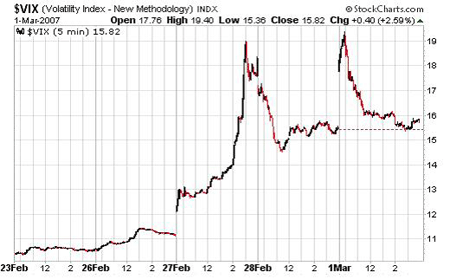
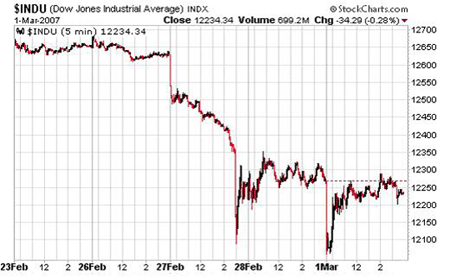
To what can we attribute such a move? Who's to blame?
Not very much has changed over the past week. Simply put, risk now matters. The market often chooses to ignore fundamentals until they suddenly matter. After nearly everyone's joined the bullish camp, the slightest defection back toward the bearish camp can produce the type of market action that we saw Wednesday. Markets go into a free fall when buyers sit on their hands, waiting for the plunge to stop.
For too long, the market has been caught up in such pointless distractions as anticipating the Fed's next interest rate move or using the three-week Northeast U.S. weather forecast to trade natural gas futures. While such distractions make nice stories for the financial media, they shouldn't form the foundation of investment decisions.
My advice to Whiskey & Gunpowder readers is to take a good look at the fundamentals supporting the value of every stock you own. Then separate the wheat from the chaff. You want to buy and hold solid companies with favorable macroeconomic winds at their backs. And you want to avoid overpaying for these shares.
What would I define as "overpaying"? Here's where we delve into the art/science of security analysis. A stock may appear cheap if it has just delivered a few years' worth of impressive earnings results. But it may, in fact, be expensive if a one-off economic event like the housing bubble temporarily boosted earnings. If earnings per share decline 50%, a 15 P/E stock immediately becomes a 30 P/E stock. Traders will punish this stock, likely pushing it back down to its typical 15 P/E range - or below.
How to avoid overpaying for stocks
How can we judge if the market is cheap or expensive when earnings fluctuate so wildly? One of the best ways to do this is to calculate the market's price-to-peak-earnings ratio. The market as a whole is pretty well defined by the S&P 500, an index of the largest 500 stocks on U.S. exchanges (measured by market value). It's now trading at about 18 times peak earnings, so it's quite expensive by historical measures. And peak earnings happen to be the earnings from the last 12 months, when conditions have hardly been better for Corporate America.
Steve Saville, editor of The Speculative Investor, incorporates Austrian Economics-based analysis and advanced charting into his newsletter ideas. He was kind enough to allow me to reproduce the following chart for Whiskey & Gunpowder readers:
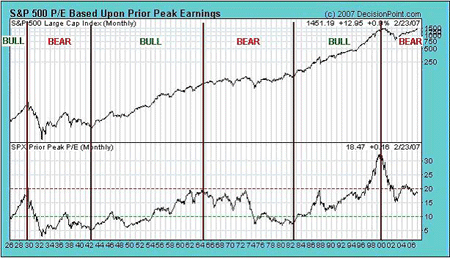
Source: www.speculative-investor.com
Steve dissected 80 years of market history into secular (long-term) bull and bear markets. Only instead of using indexes, he defines bull markets as periods of expanding P/E ratios and bear markets as periods of contracting P/E ratios. Market prices and earnings can move up together, down together, or independently of each other. But major peaks and valleys in the price-to-peak-earnings ratio provide reliable signals of change in the market's long-term tide.
The public's fear of consumer-level inflation spiraled out of control in the 1970s. This period was pretty unique in financial market history. It demonstrated that investors are not willing to pay a high multiple of earnings in a high CPI (consumer price index) environment. Look at the 1966-1982 bear market in the chart. While earnings grew rather dramatically over this 16-year period, the S&P went practically nowhere. The price-to-peak-earnings ratio compressed all the way down to about 8 by 1982. Who cares about earnings growth if it just keeps pace with CPI inflation?
I agree with Steve that we are in a secular bear market similar to the 1966-1982 market, where the index went nowhere, but the price-to-peak-earnings ratio contracted to single digits. While history never repeats exactly, it often rhymes.
If I had to go out on a limb and choose the most likely outcome over the next decade, I'd expect the S&P 500 will fluctuate in a trading range between 1,000-1,500, while earnings grow enough to push the price-to-peak-earnings ratio back below 10.
Look also at the 1995-2000 period on the price-to-peak-earnings chart. The initial dividend yield was low starting in 1995, and dividends didn't grow much over the next five years, but returns were huge. Investors were willing to pay double the P/E ratio to get into stocks because they feared missing out on the biggest boom in history. These market returns were driven by speculation, not fundamentals, and the consequences were costly during 2000-2002.
Why energy stocks will benefit from greater volatility
So which market sectors will remain attractive investments through a period of higher market volatility? You want to own companies that produce what consumers need and can afford without exotic financing arrangements. The energy sector provides a great starting point for your search.
Veteran economist Ed Yardeni produces great chart books. Here is one that provides us with a good perspective on how much energy sector earnings have contributed to overall S&P 500 earnings. Since the 2003 bottom, energy stocks in the S&P 500 have grown from 5% to 10% of the index's market value. But this huge price move was supported by fundamentals. Energy's share of total S&P 500 earnings grew from 6% to 13% over this time frame. This trend has plenty of room to run over the next decade because the bull market in energy stocks has not pushed them to overvalued levels:
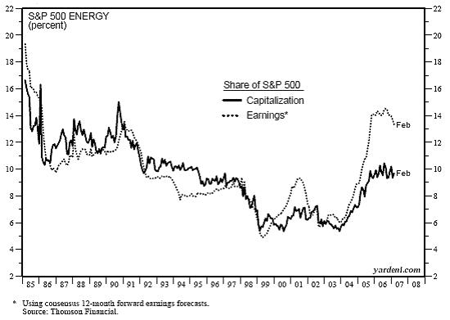
Source: www.yardeni.com
Many are worried that the commodity pricing environment cannot possibly get any better. But at 3% of the average family budget, gasoline is not prohibitively expensive. Neither are the other energy commodities. Gasoline prices could climb to 10% of the family budget without significantly altering demand.
If this were to happen, consumers would just cut 7% worth of discretionary or leisure spending to offset this price hike. Given the good probability of this occurring over the next 10 years, you want to own stocks whose earnings benefit from higher energy prices and avoid stocks whose earnings will be undercut by them.
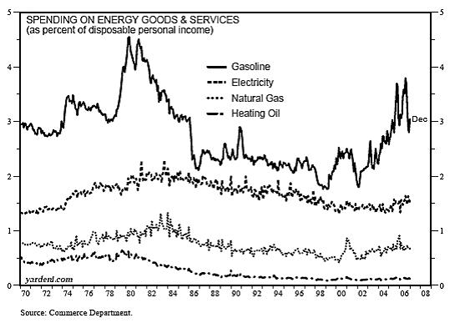
Source: www.yardeni.com
The likely impact of government intervention
Odds are good that the government will eventually throw a wrench into orderly free market gasoline pricing. Many in Congress think that consumers should not have to prepare for a long period of expensive gasoline. The U.S. Congress appears ready to fight on their behalf if this occurs. The Oil & Gas Journal reports:
"U.S. House Rep. Bart Stupak (D-Mich.) introduced legislation aimed at preventing price gouging for gasoline, natural gas, and other forms of energy. The bill, which has 78 cosponsors, would give the Federal Trade Commission explicit authority to investigate and prosecute anyone found artificially inflating energy prices, he said
"Under the bill, FTC would be empowered to exercise its new authority at each stage of energy production and distribution. It would be allowed to impose fines up to $150 million against corporations and fines up to $2 million and jail sentences up to 10 years for individuals found guilty of price-gouging
"Stupak said that during the 109th Congress, 123 House members cosponsored a similar bill he wrote, and several more signed a discharge petition to bring it to the floor. There was strong support for my bill, but the Republican leadership blocked it from being considered. This Congress, I look forward to working with my colleagues on both sides of the aisle and to help protect the American consumer from energy price gouging,' he said."
This sounds frighteningly similar to Venezuelan dictator Hugo Chavez's actions in Venezuela. He is threatening fines and imprisonment for shopkeepers who hike prices above a government-mandated inflation limit. But these sorts of price controls only prompt suppliers to start smuggling and black market operations. One way or another, the free market will ensure that goods like gasoline supplies will flow to consumers willing to pay the highest prices.
The government tried price controls in the 1970s and only created frustrating gas lines. Thinking that they help the little guy, price controls actually bring about the very shortages that lead to hoarding and inflationary spirals.
But government influence over the economy doesn't stop in Congress. The Federal Reserve is the other half of the dynamic interventionist duo, with plenty of inflationary tools at its disposal.
What happens when liquidity dries up?
"Liquidity" has become the new buzzword explaining why financial markets have remained tranquil and expensive. But the past few days of action in the stock and credit default swap markets hint that this wave of liquidity may be drying up.
A good parallel to the wave of liquidity was the IPO environment for tech stocks in 1999-2000. Companies with little chance of developing profitable business models were easily financed. Investors lined up around the block, desperate to buy ownership stakes.
Near the peak of the Nasdaq, speculative demand for IPOs indicated that we were in a new era of easy financing for IPOs. Liquidity seemed abundant. But within months, it had vanished and every tech IPO over the next few years became difficult to finance. Subprime mortgage lenders are the IPO buyers of the housing bubble, and they have left the market completely or dramatically tightened lending standards.
Markets can seize up and go into free fall when a flood of free market financing dries up. New Century and NovaStar will certainly not be hungry for subprime paper. They'll be lucky to survive their recent implosions.
So the Federal Reserve will attempt to rise to the rescue. Many believe that it will be powerless against the forces of deflation, but it's not smart to bet against central bankers' ability to destroy the value of paper money. The Fed will act in concert with most central banks around the world to keep the inflation game going.
A large, increasing global debt load creates constant demand for the money and credit necessary to service it, and if the free market refuses to supply the money and credit, central banks will. The free market's supply of credit dried up during the Great Depression and the Fed's inflationary ability was hampered by early 20th-century banking and monetary policy restrictions. It was powerless to stop a cycle of defaults.
The Fed's 21st-century inflationary tool kit is far more potent and flexible. Deflation cannot happen when governments can create infinite quantities of money and credit at zero cost - and are insensitive about returns on investment, malinvestments, bubbles, and ever-growing trade deficits.
But bailouts do not happen without consequences. The faster central bankers inflate their currencies, the faster gold will return to its place as real money in the eyes of the public. You'll want to have a full allocation of gold-related investments as insurance.
How to prepare for the next wave of inflation
So the Fed and the federal government will attempt to magically protect us from both stock market crashes and gasoline shortages. After years of relative tranquility, stock market investors are due for some turbulence. If you are exposed to financial markets, it's not too late to reassess the fundamentals supporting the value of your investments.
In the inflationary environment I expect, you'll want to avoid holding long-term bonds and increase exposure to select precious metals, energy, and "old economy" infrastructure stocks and minimize exposure to consumer discretionary stocks. Companies vital to the production of devloped and emerging market economy needs - energy, food, and water - will enjoy strengthened competitive positions.
Replacement values of the physical assets on their balance sheets will grow year after year, supporting their stocks' values. An entrepreneur (assuming environmental permitting were even possible) could probably not construct an oil refinery for anything less than twice the cost of buying the portfolio of refineries offered by shares of Valero in the stock market.
Conversely, what sorts of barriers to entry characterize an apparel retailing business? All you need is access to credit, low-cost clothing supplies, and a lease at the local shopping center. Companies that can deliver consistent, sustainable (i.e., not one-off, housing bubble-driven) earnings should assume market leadership positions in the near future.
I plan on profiling such companies for my readers and for attendees of the March 14-17 Investment U conference in Phoenix.
By Dan Amoss for Whiskey and Gunpowder
Whiskey & Gunpowder is a free, twice-per-week, e-mail service for more from the team, go to https://www.whiskeyandgunpowder.com
Get the latest financial news, insights and expert analysis from our award-winning MoneyWeek team, to help you understand what really matters when it comes to your finances.
MoneyWeek is written by a team of experienced and award-winning journalists, plus expert columnists. As well as daily digital news and features, MoneyWeek also publishes a weekly magazine, covering investing and personal finance. From share tips, pensions, gold to practical investment tips - we provide a round-up to help you make money and keep it.



